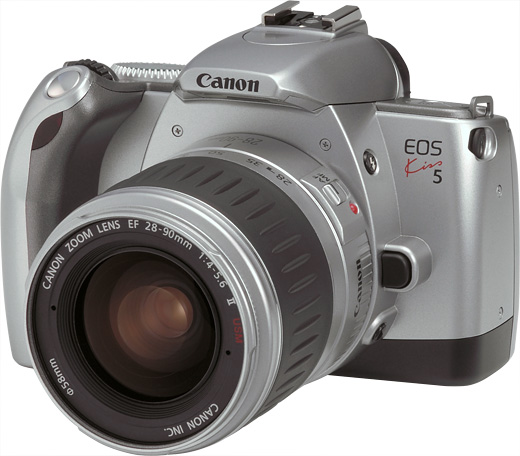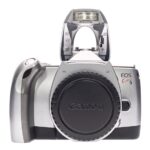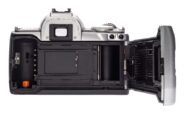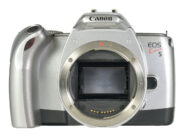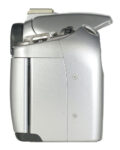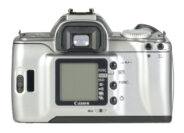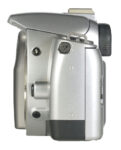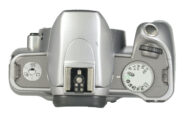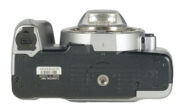Canon EOS Rebel Ti
aka Canon EOS 300V
aka Canon EOS Kiss 5
35mm AF film SLR camera
Specification
| Production details: | |
| Announced: | September 2002 |
| System: | ● Canon EOS (1987) |
| Format: | |
| Maximum format: | 35mm full frame |
| Film type: | 135 cartridge-loaded film |
| Mount and Flange focal distance: | Canon EF [44mm] |
| Shutter: | |
| Type: | Focal-plane |
| Model: | Electronically controlled |
| Speeds: | 30 - 1/2000 + B |
| Exposure: | |
| Exposure metering: | Through-the-lens (TTL), open-aperture |
| Exposure modes: | Programmed Auto |
| Aperture-priority Auto | |
| Shutter-priority Auto | |
| Manual | |
| Physical characteristics: | |
| Weight: | 365g |
| Dimensions: | 130x88x64mm |
Manufacturer description #1
August 27, 2002
CANON ANNOUNCES THE NEW EOS 300V:
A BOLD DESIGN MOVE FOR CANON'S BEST SELLING SLR
Canon, a leader in photographic and imaging technology, launches the next generation Canon EOS 300V. Canon is launching the EOS 300V to build on the success of its predecessor and to become the benchmark for auto focus (AF) SLR cameras.
The EOS 300V is the successor to Canon's number one best seller AF SLR, the EOS 300. Combining a bold and innovative design with new and improved features, the EOS 300V is set to follow in its footsteps.
The Canon EOS 300V heralds a new look for Canon SLR cameras with a smaller body and a stylish new low-contrast, two-tone metallic finish which does not compromise looks for performance.
Mark Robinson, Marketing Manager, Canon Consumer Imaging says, "The EOS 300V is evidence that we continue to invest heavily in the analogue market. In today's competitive SLR market, it is imperative that we continue to offer consumers not only exceptional SLR products but also an extensive range of EF lenses and accessories to provide users with the highest quality results."
Technology
A new microcomputer and improved AF algorithm and AF sequence means that the EOS 300V now offers users the fastest AF speed in its class. This allows the EOS 300V's improved predictive AF focusing to be on a par with that of higher end models in the Canon range.
The EOS 300V's newly developed AF point superimposed (SI) display enables users to see when focus has been achieved or when the AF point has been selected. Whilst the easy viewing LCD panel is now 2.8 times larger and allows users to observe a selection of shooting data including three new additions: Shooting mode, Film Advance mode, and the Date and Time on Quartz Data Model. The LCD panel can also be illuminated for easy viewing.
Also new to this model is an added Programmed Image Control function of "Flash off" mode to disable the flash or external speedlites for places where flash photography is not permitted or inappropriate. Other extra features include a metal lens mount and improved battery life.
A new coreless motor and an improved mirror-locking system allow the EOS 300V to reach an improved film advance speed of 2.5 frames per second. The new film advanced mode button allows users to set one of three film advance modes: single frame shooting, continuous shooting and self-timer control in the Creative Zone mode.
The grip of the EOS 300V has also been redesigned for optimum comfort and the Command dial on the right shoulder of the camera now enables one-hand operation for added functionality.
Other features include the seven AF point CMOS sensor, which enables the camera to focus on off centre subjects and the 35-Zone metering which takes readings from 35 different zones of the frame and compares the results with built-in pre-defined patterns. In conjunction with the focusing points the camera detects difficult lighting situations and adjusts the exposure accordingly. The EOS 300V also has a built in retractable E-TTL autoflash, which is linked to the multiple focusing point, and when the flash pops up the red eye reduction mode is activated.
Accessories
The EOS 300V comes equipped with a new collection of accessories such as: Battery Pack BP-220 (dedicated to EOS 300V), Semi-hard Case EH 15-L, Eye Cup EF and Rubber Frame EF.
EOS 300V Kits
The following new lenses have also been launched simultaneously to allow users to gain optimum results:
- EF 28-90mm f/4-5.6 II and EF 28-90mm f/4-5.6 II USM
- EF 28-105mm f/4-5.6 and EF 28-105mm f/4-5.6 USM
- EF 90-300mm f/4.5-5.6 and EF 90-300mm f/4.5-5.6 USM
The EOS 300V is available in a range of single and twin kits. The single kit consists of the EOS 300V body and is available with one of the following new lenses: EF 28-90mm f/4-5.6 II, EF 28-90mm f/4-5.6 II USM or the EF 28-105mm f/4-5.6 USM. The single kit comes with a wide strap, body cap RF3, eyecup EB, and 2xCR-2 lithium batteries.
The EOS 300V twin kit offers users the same choice as the single kits but also features the addition of either the EF75-300mm f/4.0-5.6 III or the EF75-300mm f/4.0-5.6 USM III. The twin kit comes with camera bag, two rolls of film, a wide strap, body cap RF3, eyecup EB, and 2xCR-2 lithium batteries.
A date model is also available for users who wish to have the option of adding dates on the prints, as well as wireless remote control functions.
Manufacturer description #2
The EOS 300V combines high-end features with a metallic, compact, lightweight and robust design. Seven focusing points, and the fastest AF area in its class*), mean that the camera focuses quickly. The active focusing point super imposes in red in the viewfinder. The exposure metering system uses 35 zones, linked to the active focusing point. The command dial has been moved to the right, enabling you to operate all the main controls with one hand. Besides the usual 5 basic Programmed Image Control shooting modes, there is a new mode "flash-off" which disables the built-in flash, or an attached Speedlite. The LCD panel has been moved to the back of the camera and is about three times larger than the panel on the EOS 300. The camera has a wide choice of accessories and the metal EF mount is compatible with over 60 EF lenses.
* as of August 27, 2002
Manufacturer description #3
The Canon EOS Kiss 5 is the addition to the company’s best-selling EOS Kiss series of affordable AF SLR cameras. Featuring a high-speed-processing microcomputer and new algorithms, the new camera achieves not only the fastest AF speed in its class, but also vastly improved predictive AF performance when shooting moving objects. Innovatively designed, the new EOS Kiss 5 redefines the image of SLR cameras with an elegant incandescent-silver and metallic-gray exterior finish, and a compact (130 x 88 x 64mm), lightweight (365g) body featuring an ergonomic handgrip for maximum user comfort and functional ease. Enhancing utility, the rear panel of the new model incorporates a large-size (30 x 30mm) LCD panel with backlight, enabling camera settings to be seen clearly even in dark conditions. Moreover, all main operating controls are grouped together on the right side of the camera to enable the operation of most functions with one hand.
Table of contents
Clickable
Instruction manual
Clickable
Canon EOS system cameras
Clickable
- Canon EF-M
- Canon EOS 10 S
- Canon EOS 10D
- Canon EOS 1D
- Canon EOS 1D mark II
- Canon EOS 1D mark II N
- Canon EOS 1D mark III
- Canon EOS 1D mark IV
- Canon EOS 1D X
- Canon EOS 1D X Mark II
- Canon EOS 1D X Mark III
- Canon EOS 1Ds
- Canon EOS 1Ds mark II
- Canon EOS 1Ds mark III
- Canon EOS 3
- Canon EOS 3000
- Canon EOS 5000
- Canon EOS 5D
- Canon EOS 5D mark II
- Canon EOS 5D mark III
- Canon EOS 5D mark IV
- Canon EOS 5Ds
- Canon EOS 5Ds R
- Canon EOS 620
- Canon EOS 630
- Canon EOS 650
- Canon EOS 6D
- Canon EOS 6D Mark II
- Canon EOS 700
- Canon EOS 750 QD
- Canon EOS 850
- Canon EOS A2
- Canon EOS D30
- Canon EOS D60
- Canon EOS ELAN
- Canon EOS ELAN 7E
- Canon EOS ELAN 7NE
- Canon EOS ELAN II
- Canon EOS IX
- Canon EOS IX Lite
- Canon EOS Rebel 2000
- Canon EOS Rebel G
- Canon EOS Rebel K2
- Canon EOS Rebel S II QD
- Canon EOS Rebel T2
- Canon EOS Rebel Ti
- Canon EOS Rebel X
- Canon EOS Rebel XS
- Canon EOS Rebel XS N DATE
- Canon EOS RT
- Canon EOS-1
- Canon EOS-1N
- Canon EOS-1N RS
- Canon EOS-1V
